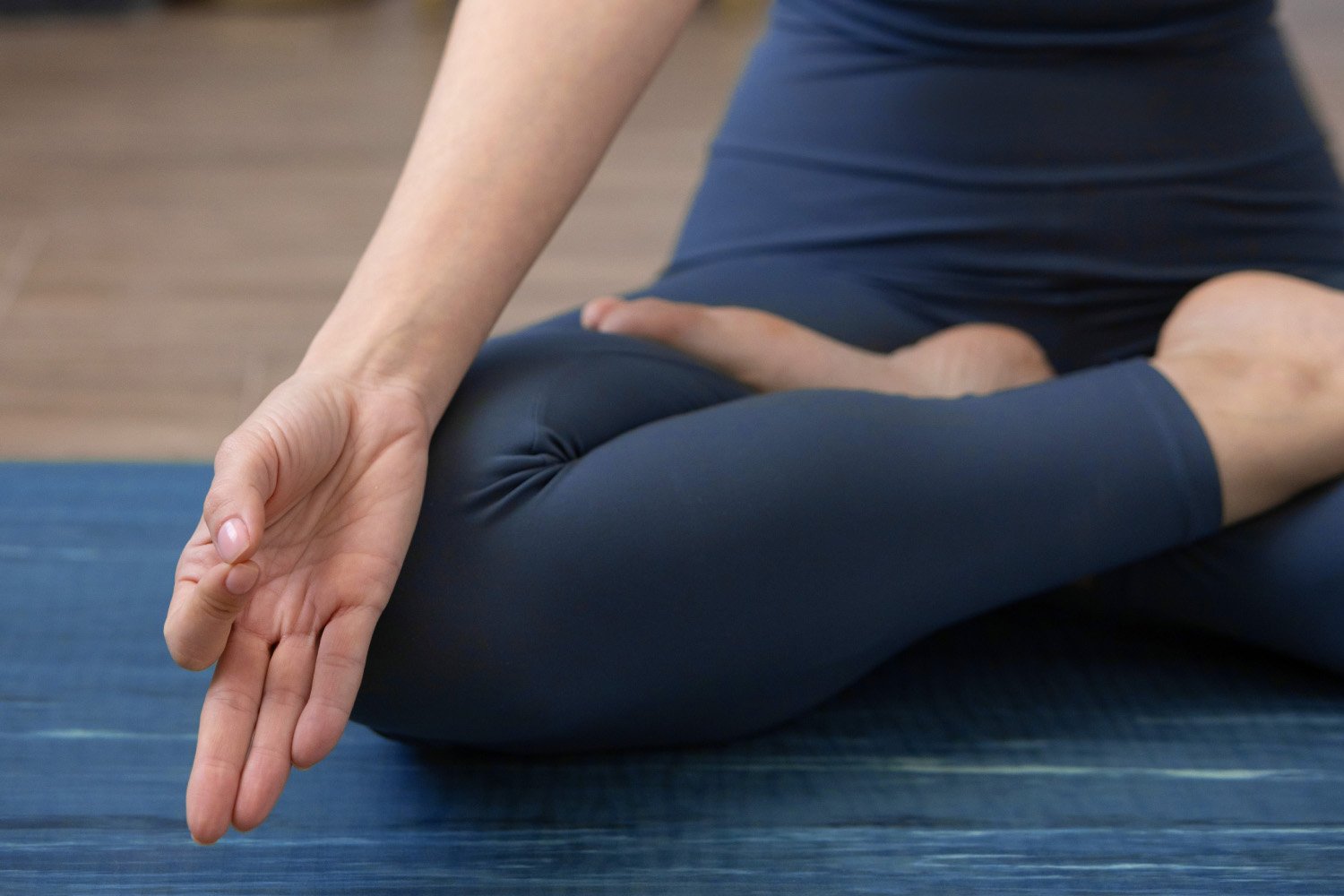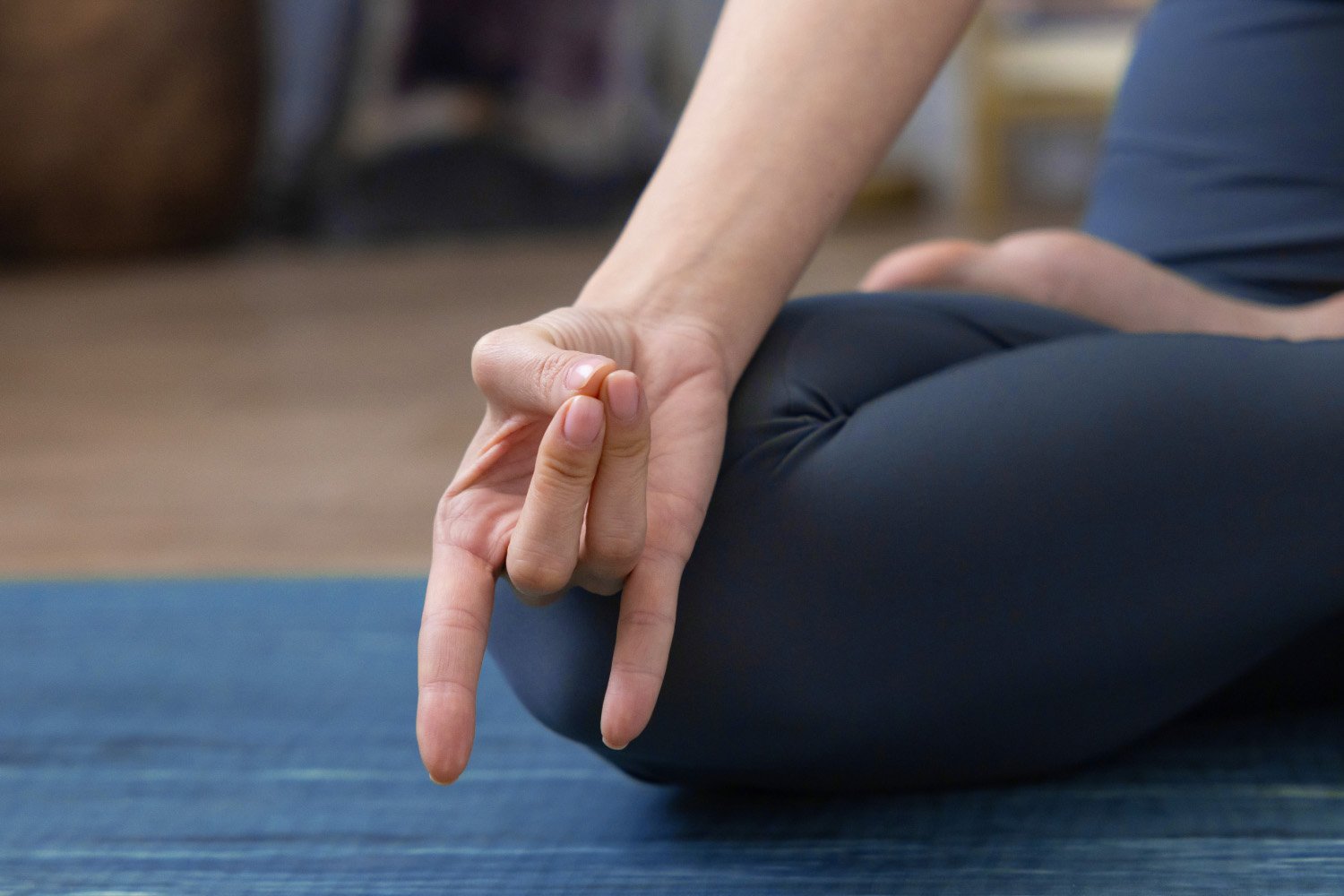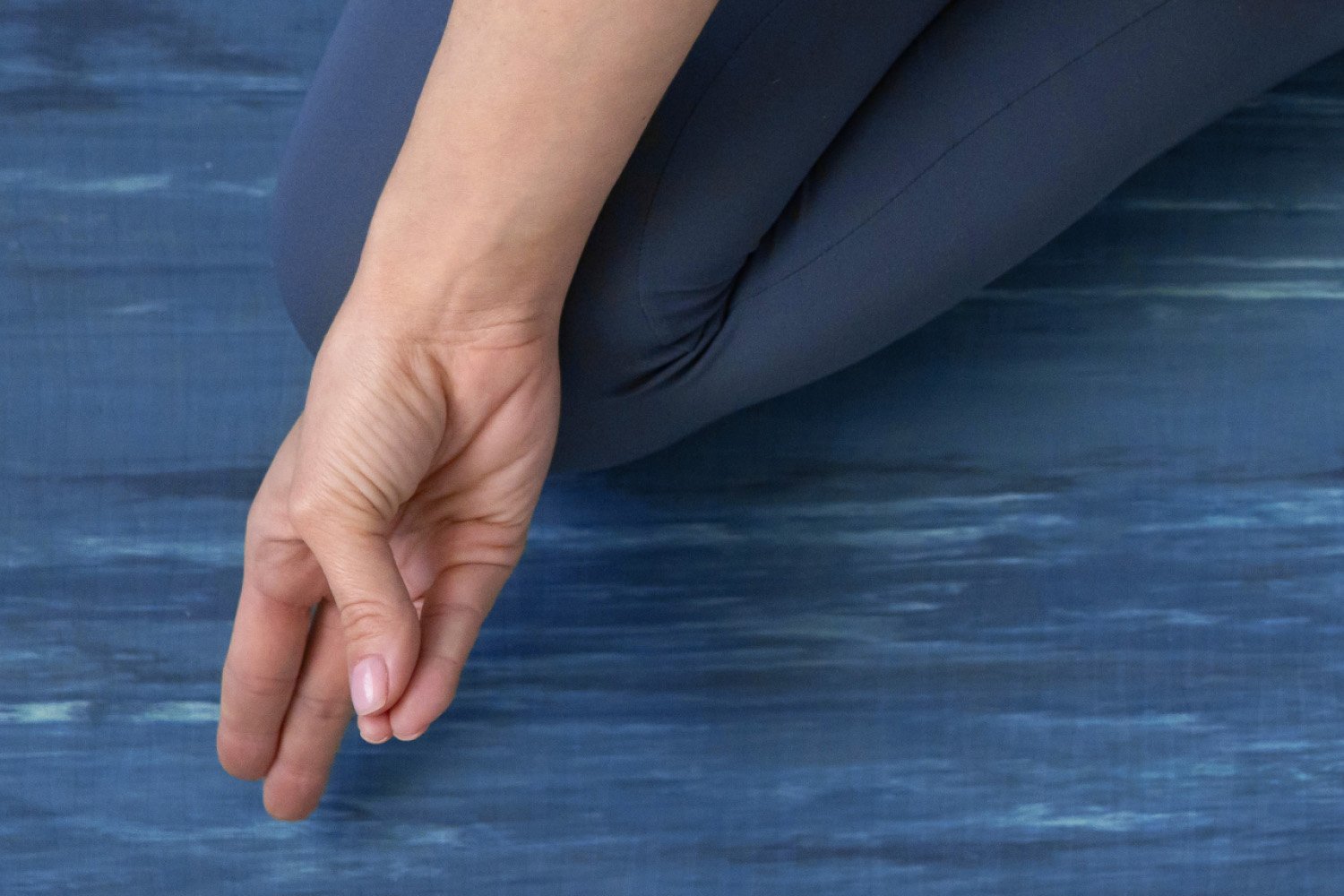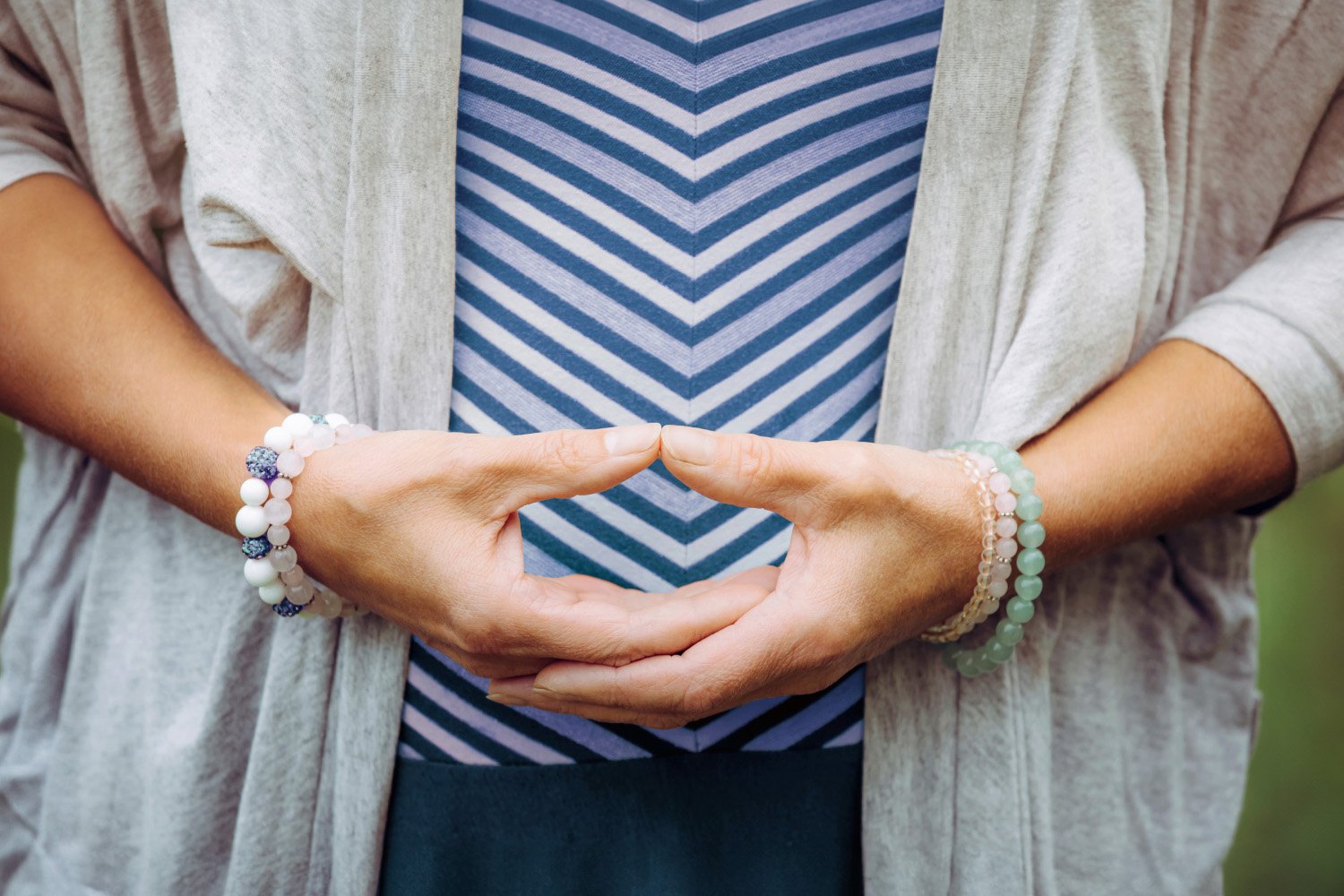9 hand positions for meditation to add to your practice

Clinically reviewed by Dr. Chris Mosunic, PhD, RD, CDCES, MBA
Explore the history, benefits, and meaning of using mudras during meditation. Plus, 9 powerful hand positions to enhance your meditation practice.
Many people know that meditation can invite calm and clarity into their lives. But you may not have realized that hand positions, or mudras, can deepen meditation sessions and provide a focal point for concentration.
Hand positions are believed to influence the flow of energy within the body to promote physical, emotional, and spiritual healing. Whether you're stepping into meditation for the first time or deepening your existing practice, mudras can add new meaning and connection.
What are mudras or hand positions?
Mudras, commonly referred to as hand positions, are a fundamental aspect of meditation and yoga practices. These gestures, deeply rooted in ancient Indian spiritual and healing traditions, are considered to be a language of the soul, expressing and channeling the body's energy and intentions. The term "mudra" is derived from Sanskrit, with "mud" meaning joy and "ra" meaning produce, suggesting that mudras are means to generate joy and happiness.
In ancient tradition, positioning the hands and fingers in specific ways is believed to direct internal energy (prana), to areas that need healing or energizing. This manipulation of prana is believed to help balance the body's elements and chakras, potentially leading to improved health and heightened consciousness.
In meditation, mudras are used as focal points to help quiet the mind, concentrate on breathing, and enter deeper states of meditation. When used with intention, they can enhance the meditative experience, creating a sense of purpose and direction. Many use hand positions to help guide self-discovery and transformation.
Mudras in meditation and yoga practices may help deepen the feeling of connection to the self and the universe. By bringing hand gestures into your practice, you open yourself to many potential benefits.
5 benefits of using mudras for meditation
Even simple hand gestures can have a big impact on your meditation practice. Whether you're looking to deepen your meditation, manage stress, or explore spiritual dimensions, mudras can help you on your journey. Mudras may lead to:
1. Improved focus and concentration: Mudras can provide a focal point to help keep your mind from wandering, encouraging a deeper state of meditation.
2. Reduced stress and anxiety: Many mudras are specifically designed to promote relaxation, lower stress levels, and relieve anxiety.
3. Enhanced mind-body connection: Mudras encourage practitioners to engage actively with their meditation practice, bringing a deeper awareness of the body and its connection to mental and emotional states.
4. Increased energy flow: According to traditional beliefs, mudras can influence the flow of energy, or prana, within the body. Specific hand gestures aim to help unblock and direct energy to areas that need healing or revitalization.
5. Spiritual development: For those on a spiritual path, mudras may help you explore deeper realms of consciousness and connect with divine energies. Each mudra has its own symbolic meaning and purpose, often associated with specific qualities or deities. Hand gestures can be a form of devotion or invoke particular spiritual states.
9 hand positions to try in your meditation practice
Experimenting with mudras during your meditation practice can bring new experiences and understanding. Each mudra has a unique purpose, allowing you to adapt your practice for your needs and intentions.
1. Gyan mudra
This mudra is often associated with wisdom and knowledge. To perform it, touch the tip of your thumb to the tip of your index finger, with the other three fingers extended straight. This gesture is believed to improve concentration and memory, stimulate the root chakra, and encourage a sense of calm. It's an excellent starting point for beginners.
2. Vayu mudra
Thought to reduce anxiety and calm the mind, the Vayu mudra can be achieved by placing the index finger under the thumb, with the other three fingers extended straight. This position may help manage nervousness and restlessness, benefiting those experiencing stress or anxiety.
3. Apana mudra
The Apana mudra is known for its detoxifying properties. It involves touching the tips of the thumb, middle finger, and ring finger together while keeping the other fingers extended. This gesture is believed to aid in digestion and the elimination of waste and toxins from the body, promoting physical and emotional cleansing.
4. Buddhi mudra
In this hand position, the tip of the thumb touches the tip of the little finger, with the other fingers extended. It's said to support communication and inner clarity.
5. Prana mudra
Touch the tips of the thumb, ring finger, and little finger together, while keeping the other two fingers extended. This gesture is associated with vitality and energy, believed to invigorate the life force within the body. It's recommended for those looking to boost their energy levels.
6. Bhairava mudra
The Bhairava mudra involves placing one hand in the palm of the other in your lap and is thought to provide a sense of security and inner balance. This gesture is often used for deep meditation and reflection, as it can promote a feeling of protection and stability.
7. Ganesha mudra
Named after the Hindu deity Ganesha, who is known for removing obstacles, this mudra requires clasping your hands in front of your heart, with elbows pointing outward. It's believed to strengthen the heart, increase confidence, and remove internal and external barriers to success.
8. Palms down
Placing your hands on your knees with palms facing downward signifies grounding. This position is thought to stabilize energy and bring a deep sense of connection to the earth, which can enhance meditation.
9. Samadhi mudra
Representing complete concentration and a state of bliss, this mudra involves folding the hands in the lap, palms up, with one hand resting on top of the other. It symbolizes the unity of the individual soul with the universal soul, and is thought to promote deep meditation.
How to find what hand positions work for you
Adding mudras into your meditation practice can offer physical, mental, and spiritual benefits. While mudras offer a meaningful way to deepen your meditation practice, the most important thing is to find what works for you. After all, their effectiveness can depend on your intention, comfort, and belief in the practice. By staying open-minded, setting intentions, and listening to your body, you can discover the hand positions that best support your meditation journey.
Explore and experiment
Begin with simple mudras, such as the Gyan or Anjali mudra, and then experiment with more complex ones. Pay attention to how each mudra makes you feel during and after meditation. Some may bring immediate calm, while others might energize you or promote deeper introspection.
Listen to your body and mind
As you experiment with various mudras, pay attention to how they make you feel. Mudras are meant to support and enhance your meditation, not cause discomfort or distraction. If a particular hand position is uncomfortable or doesn't feel right, adjust or skip it altogether. The key is to maintain a practice that feels nurturing and supportive.
💙 Take a moment to connect with what’s going on in your mind and body after practicing with a mudra by Checking in With Yourself during this short session.
Set clear intentions
Before bringing a mudra into your practice, set a clear intention. Whether you're seeking to calm your mind, increase your energy level, or deepen spiritual connection, aligning your intention with the chosen mudra can greatly enhance its effectiveness.
💙 Learn how to set Better Intentions for your meditation practice, and life.
Regular practice and patience
Mastering mudras takes practice and patience. Over time, you may find that some mudras become more powerful for you, reflecting your growth and evolution in your meditation journey.
💙 If you find yourself getting frustrated with your progress, try some mindful movement to work through Impatience.
Personalize your practice
The most effective meditation practice is one that’s tailored to your individual needs and goals. Combine mudras with other techniques, such as visualization, mantra chanting, or focused breathing, to create a meditation experience that supports your wellbeing.
Reflect and adjust
Regular reflection on your practice can provide valuable insights into what works best for you. Keep a meditation journal to note your experiences, feelings, and any changes you observe over time to help you adjust and refine your use of mudras.
💙 Explore The Power of Reflection during this session of the Daily Jay.
Hand positions for meditation FAQs
What are the hand positions for Zen meditation?
In Zen meditation, the most commonly used hand position is the cosmic mudra, also known as the Dhyan mudra, which symbolizes the unity of all things. To adopt this gesture, place your right hand on your lap, then place your left hand on top of your right hand, palms facing upward. Gently touch the tips of your thumbs together, forming a slight oval shape. This mudra can help bring calm and concentration, and help you achieve deeper states of meditation.
What is the most powerful hand mudra?
The most powerful hand mudra depends on your individual needs and the benefits you’re seeking from your meditation practice. However, many people find the Gyan mudra to be particularly helpful for enhancing concentration, memory, and a sense of inner peace. This mudra is formed by touching the tip of the thumb to the tip of the index finger, with the other three fingers extended straight.
Do hand mudras really work?
Many people who use hand mudras swear by them. According to both ancient traditions and some modern practitioners, mudras can influence the body's energy flow and balance, potentially affecting physical, mental, and spiritual wellbeing. While scientific research on mudras is limited, a few benefits that people have reported include reduced stress, improved concentration, and enhanced emotional balance. The effectiveness of mudras can also depend on what you’re hoping to achieve and how regularly you use them.
What mudra should I use?
The mudra you choose should align with your personal meditation goals. For enhancing concentration and mental clarity, try the Gyan mudra. If you're looking to reduce anxiety, the Vayu mudra might be your best bet. For those interested in detoxification and physical health, explore the Apana mudra. Test different mudras and see how each one affects you.
Are mudras spiritual?
Mudras can be both spiritual and non-spiritual, depending on how they’re used and the context of the practice. In some traditions, mudras are seen as sacred gestures that can connect the practitioner to divine energies. They’re often used with mantras and visualizations and can deepen a meditation. However, mudras can also be practiced with a focus on their potential physical and mental health benefits. Whether or not mudras are spiritual can depend on your intentions and beliefs.
Calm your mind. Change your life.
Mental health is hard. Getting support doesn't have to be. The Calm app puts the tools to feel better in your back pocket, with personalized content to manage stress and anxiety, get better sleep, and feel more present in your life.
















